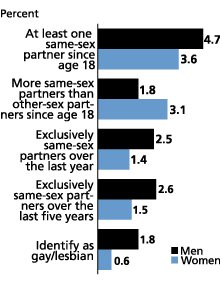
Out of the Closet and Onto the Census Long Form
(Population Today, May/June 2002) Sitcoms and talk shows have brought gay men and lesbians into the living rooms of average Americans, and talking about sexual orientation has become less taboo in recent years. But beyond stereotypes, what do we know about real-life homosexuals?
Researchers Gary Gates, of the Urban Institute, and Seth Sanders, of the University of Maryland, have spent years mining standard data sources including the census long form for insights into the gay and lesbian population in the United States. The trickiest part of doing this research, they say, is defining homosexuality.
Existing social science surveys make no attempt to define who is gay and lesbian, said Gates. He and Sanders have made that attempt based on the data available (see figure), but they acknowledge the process is not clear-cut. “The problem is, what are we asking?” said Gates. “Are we asking how many people identify as gay and lesbian? Are we asking how many people engage in certain behavior? It’s really a tough question.”
Survey Responses Used to Determine the Size of the U.S. Gay and Lesbian Population

Sources: General Social Survey, pooled from 1989-1991, 1993, 1994, and 1996; National Health and Social Life Survey (1992); U.S. Census: 2000 and 1990 (Public Use Micro Samples Combined 1 percent and 5 percent samples and Internal Long Form Files); and Behavioral Risk Factor Surveillance System.
Census results have made the researchers’ job easier. For the first time, the 1990 questionnaire allowed heads of household to mark “unmarried partner” in describing their relationship to another adult of the same sex living in the same house. And the processing of the 2000 questionnaire went one step further, with the Census Bureau recoding any same-sex “spouse” responses as “unmarried partner” responses (instead of recoding their gender).
Sources of error in the information collected this way include inaccurate reporting by respondents who fear discrimination, and misunderstanding of the term “unmarried partner” (mistaking “partner” for business associate), though Gates indicated the latter is rare. A third source he mentioned was people who are cohabiting and are in a sexual relationship but do not call it an unmarried partnership.
What have Gates and Sanders learned? They estimate that the gay and lesbian population is at least 2.5 percent of the general population, the estimate for gay men (from 2 percent to 5 percent) exceeding that for lesbians (from 1 percent to 3.5 percent). Removing the definition that refers only to experimentation (the top set of bars in the figure above) narrows the ranges to 2 percent to 3 percent for men, and 1 percent to 3 percent for women.
The figure shows more than just the size of the population. It also confirms what other sources have shown about women being more fluid in their sexuality than men. That is, “Once men identify as gay, it appears to have a stronger kind of staying power than for women,” said Gates.
Other findings include:
- Parenting. Lesbian couples do more parenting than gay male couples. In 1990, 23 percent of households headed by lesbian couples had a child under 18, compared with 6 percent of households headed by gay men.
- Military service. Lesbians have a military service rate higher than the general female population; gays have a lower military service rate than the general male population. In 1990, 7 percent of lesbians indicated they were veterans, compared with 2 percent of all women; 19 percent of gay men described themselves as veterans, compared with 39 percent of all men.
- Income. Gays earn less than other men; lesbians earn more than other women. In 1990, wages and earnings for gay men averaged $28,000, compared with $32,000 for all men. Wages and earnings for lesbians averaged $23,000, compared with $17,000 for all women.
- Place of residence. Census 2000 data show that gay men tend to live in big cities, and lesbians tend to be concentrated in smaller metropolitan areas (see table).
Ten U.S. Metro Areas With the Highest Concentrations* of Gays and Lesbians
| Gays | Lesbians |
|---|---|
| San Francisco/ Oakland |
Santa Fe, N.M. |
| Miami/Ft. Lauderdale | Burlington, Vt. |
| Santa Fe, N.M. | Portland, Maine |
| Atlanta | Springfield, Mass. |
| San Diego | San Francisco/ Oakland |
| Orlando, Fla. | Corvallis, Ore. |
| Los Angeles | Madison, Wis. |
| Seattle | Albuquerque, N.M. |
| Austin, Texas | Eugene, Ore. |
| Portland, Maine | Iowa City, Iowa |
*Percentage of households that are same-sex unmarried partners.
Source: Census 2000 data.
Answers shown in the table to the “place of residence” question bring smiles to the faces of the researchers and those to whom they present their results because the answers evoke stereotypes. Asked whether that defeats the purpose, Gates laughed and replied: “It tells you you’ve gotten a good sample.”
Allison Tarmann is editor of Population Today.
